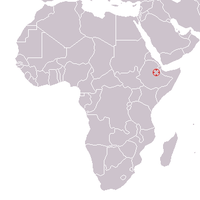Herto Man
 | |
| Common name | Herto Man |
|---|---|
| Species | Homo sapiens idaltu |
| Age | 157±3 ka |
| Place discovered | Bouri Formation, Ethiopia |
| Date discovered | 1997 |
| Discovered by | Tim D. White and Berhane Asfaw |
Herto Man refers to human remains (. The remains have been dated as between 154,000 and 160,000 years old. The discovery of Herto Man was especially significant at the time, falling within a long gap in the fossil record between 300 and 100 thousand years ago and representing the oldest dated H. sapiens remains then described.
In the original description paper, these 12 (at minimum) individuals were described as falling just outside the umbrella of "
Herto Man produced many
Research history

Fossils of Herto Man were first recovered in 1997 from the Upper Herto
This region of the world is famous for yielding a series of ancient human and
In a simultaneously published paper, anthropologists

In another simultaneously published paper, British physical anthropologist
By the time Herto Man was discovered, based on genetic analyses and the fossil record after 120,000 years ago, it was largely agreed that modern humans H. s. sapiens evolved in Africa (recent African origin model), but it was debated if this was a continent-wide or localised process. In regard to the localised model, the antiquity of the Herto Man and the several similar specimens of presumably equal or even older age distributed across East Africa shifted the focus to that region.[5] In 2017, the Jebel Irhoud remains were dated to 315,000 years ago, making them the oldest specimens classified as H. sapiens. Because this date overlaps with "H. rhodesiensis", the Irhoud remains also demonstrate that these transitional morphs, including Herto Man, represent a rapid evolution of the sapiens face, with gradual modifications to the braincase among populations distributed across Africa, beginning as early as 300,000 years ago.[9]
Anatomy

Like what could be considered an "anatomically modern human", the Herto skull has a high cranial vault (a raised forehead), an overall globular shape in side-view, and a flat face. The brain volume was about 1,450 cc. The skull is quite robust in having a projecting brow ridge, weakly curved parietal bones, and a strongly flexed occipital at the back of the skull. These traits are well within the range of variation of modern humans. Compared to the average present-day human skull, the Herto skull is notably long and has overall large dimensions, although the cheekbones are relatively weak.[1]
Culture
Technology
The Upper Herto Member is a sandy

Points and blades were made with obsidian, and other tools with fine-grained basalt, though a few scrapers were made with cryptocrystalline rock. Of the pool of 640, 48 flakes, blades, and points were made with the Levallois technique. The 28 bifaces include ovates, elongate ovates, triangulars, cleavers, and a pick, scraper, and biface core. All 17 handaxes were made with flakes and finished with soft hammering. Out of the 25 side scrapers, 22 were simple (only one side could scrape). There were 15 end-scrapers (only one or both of the ends could scrape), and a few were rounded off, somewhat resembling Aurignacian (40,000 years ago) end-scrapers.[3]
Both the Lower and Upper Herto Members preserve several
Mortuary practices
The adult BOU-VP-16/1 shows a weak, thin 35 mm (1.4 in) vertical cut on the bottom corner of his right parietal bone, and another smaller vertical line across the right temporal line. The adult BOU-VP-16/2 bears intense modification of 15 of his 24 associated skullcap fragments, as well as deep cut marks consistent with defleshing on his parietals, left cheekbone, frontal bone, and occipital bone. BOU-VP-16/2 also presents evidence of repetitive scraping around the circumference of the braincase (generally interpreted as a symbolic modification rather than for consumption), and the lack of fragments from the base of the skull may mean the specimen was deposited as an isolated skullcap to begin with. The juvenile BOU-VP-16/5 has deep cut marks consistent with defleshing all along the undersides of the sphenoid and temporal bones, likely after the jawbone was removed. The occipital bone and foramen magnum (the base of the skull) were broken into, and the edges were polished and smoothed off, which is similar to the mortuary practices of some Papuan tribes. These could indicate that Herto Man was symbolically preparing the dead in some mortuary ritual.[3]
See also
References
- ^ S2CID 4432091
- ISBN 978-1-118-65990-8.
- ^ S2CID 4312418.
- ^ a b Lubsen, K. D.; Corruccini, R. S. (2011). "Morphometric Analysis of the Herto Cranium (BOU-VP-16/1): Where Does It Fit?". Journal of Contemporary Anthropology. 2 (1).
- ^ S2CID 26693109.
- PMID 25063564.
- PMID 27298468.
- ISBN 978-3-935751-30-8.
- S2CID 205255859.
